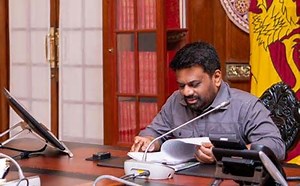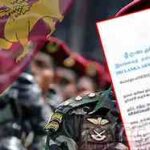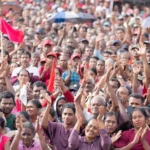
“Sri Lanka’s 2025 Budget: Balancing IMF Rules, Revenue Targets & Reforms”
- CNL Reporter
- February 17, 2025
- Political
- Sri Lanka’s 2025 Budget:
- 0 Comments
News of the Day
President Anura Kumara Dissanayake is set to present the first budget of the newly elected JVP-led National People’s Power (NPP) government in Parliament today (Monday, 17th).
This marks Sri Lanka’s 79th successive national budget and is expected to outline a comprehensive plan for economic stability and growth under the framework of the International Monetary Fund (IMF).
On Sunday (16th), the final draft of the 2025 budget was submitted for presidential review at the Presidential Secretariat.
According to the President’s Media Division (PMD), President Dissanayake, alongside Finance Secretary Mahinda Siriwardana, held discussions focusing on the key fiscal priorities for the upcoming year.
In a post on ‘X’, the President reaffirmed his commitment to a budget that promotes both progress and stability.
Parliament is scheduled to convene at 10:30 a.m. today (17th) for the President’s highly anticipated inaugural Budget Speech.
Historic Pre-Budget Discussion and Economic Context
For the first time in Sri Lanka’s history, a pre-budget public dialogue was initiated by renowned economist, renowned Master of economics and former minister Dr. Bandula Gunawardena.
During the launch of his book, Sri Lanka Government’s Budgetary Policies and Challenges, in Colombo on Sunday (16th), Gunawardena provided insights into the fiscal landscape and economic hurdles ahead.
Sri Lanka is expecting approximately $1.36 billion in financial support under the IMF program, which is also backed by the Asian Development Bank (ADB).
Gunawardena revealed that the IMF is set to release $333 million soon, as part of its biannual review process. Additionally, Sri Lanka anticipates $400 million from the World Bank and $300 million from the ADB for the 2025 budget.
The country is also expected to receive $3.65 billion in debt relief, bridging a projected external resource gap of $5.01 billion.
By the end of 2025, Sri Lanka’s gross international reserves are projected to be $1.57 billion higher. However, under the IMF program, the country must also accumulate $250 million in foreign reserves by the first quarter of 2025 as part of a net international reserve target.
Challenges in Budget Formulation
The 2025 budget faces two major constraints. First, the government has committed to the Extended Fund Facility (EFF) program under the IMF, which mandates strict financial benchmarks. One such condition is that Sri Lanka’s government revenue—excluding privatization proceeds—must reach 15.1% of GDP.
This translates to an increase in revenue to approximately Rs. 5.5 trillion, up from Rs. 4 trillion in 2024, requiring an additional Rs. 1.5 trillion in revenue through new taxation measures.
The second constraint is the Economic Transformation Act, passed before the presidential election. This act enforces similar revenue targets, reinforcing IMF conditions and restricting government spending flexibility. Given these limitations, the government must carefully balance fiscal responsibility while addressing public needs.
Future Economic Outlook and Financial Gaps
Gunawardena highlighted that by 2027, Sri Lanka’s external fiscal gap is estimated at -$3.91 billion. To bridge this shortfall, the IMF will provide $3.29 billion under the Extended Fund Facility, along with $600 million in budgetary support. The World Bank and ADB will contribute $300 million each. However, the country will still face an unsettled accumulated debt of $1.48 billion.
The government aims to raise $1.5 billion through the issuance of International Sovereign Bonds, which will help fill the financial gap until 2027. However, beyond this period, Sri Lanka may struggle to secure further international financial assistance.
Controversial Taxation Measures
Among the proposed revenue-generating strategies is the imputed rental tax, introduced under the IMF program. This tax calculates a notional rental income for property owners, adding it to their taxable income. For example, if a house is estimated to generate Rs. 100,000 in rental income, and the owner falls under a 30% tax bracket, they would need to pay Rs. 30,000 in taxes.
President Dissanayake, who also serves as the Finance Minister, has expressed his commitment to balancing economic recovery with policies that lower taxes, enhance welfare, and support local industries—consistent with his pre-election promises.
However, these goals must be aligned with IMF-mandated targets, including maintaining a deficit of 5.2% of GDP and achieving 15.1% of GDP in government revenue to secure the next $333 million IMF tranche.
A Tightrope Walk for the Government
Dr. Gunawardena aptly described the challenge of presenting this budget as being akin to “eating curd with a straight razor.” The government faces the enormous task of avoiding excessive tax burdens on the public while ensuring adequate financial relief for vulnerable communities. Balancing these demands within the strict financial framework set by the IMF will be a difficult endeavor.
As the nation eagerly awaits the President’s Budget Speech, the coming months will reveal how well the new administration can navigate these financial pressures while striving to fulfill its economic promises.
Dr Gunawardena concluded by relating an aged old poem which highlighted the plight of a man facing threeways of death who ate honey claiming similarity to the presentation of the budget amidst three challenges

